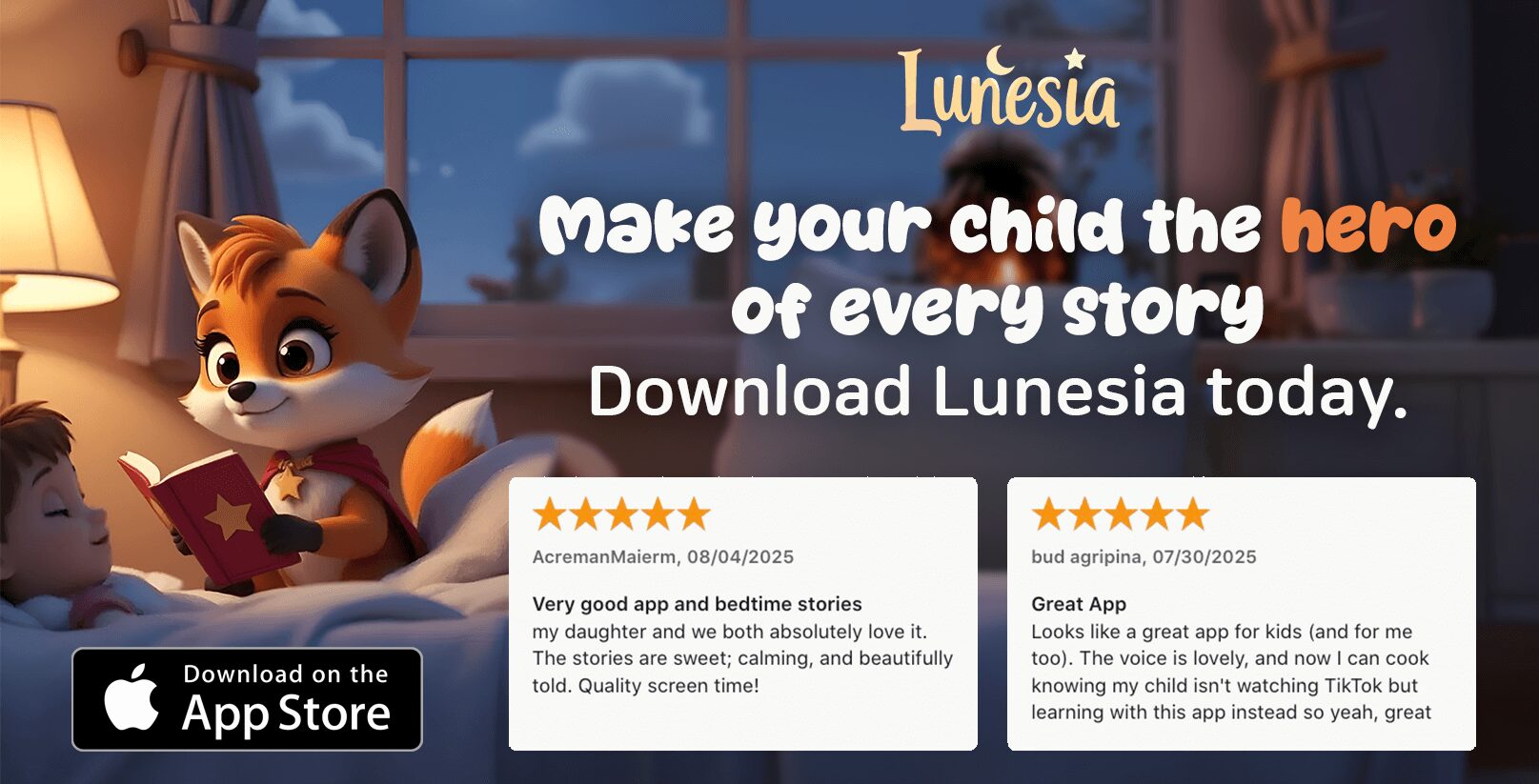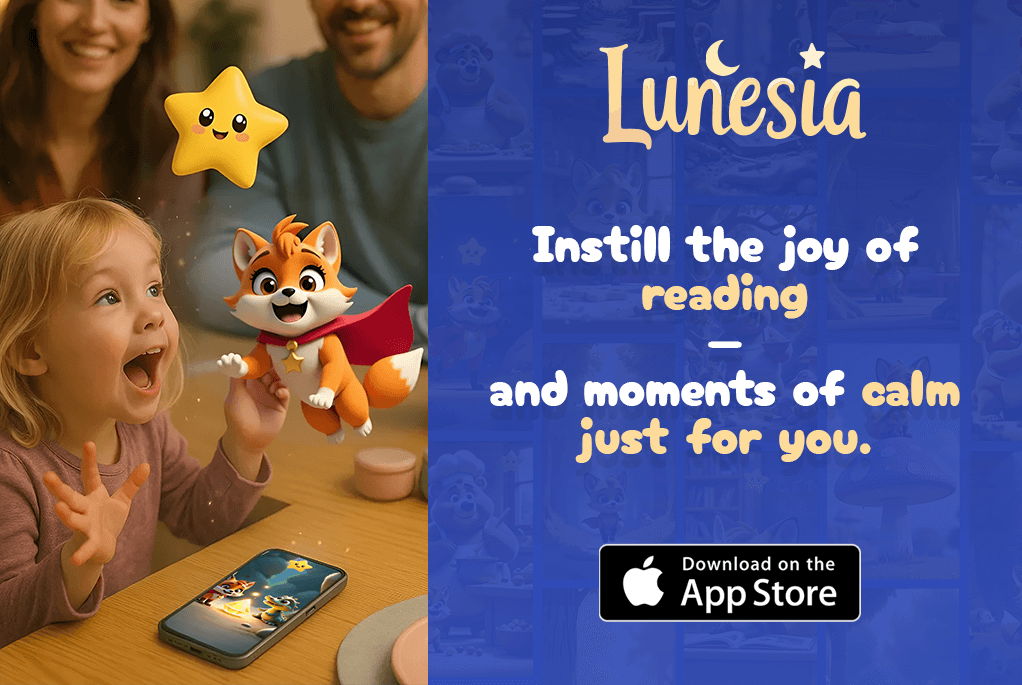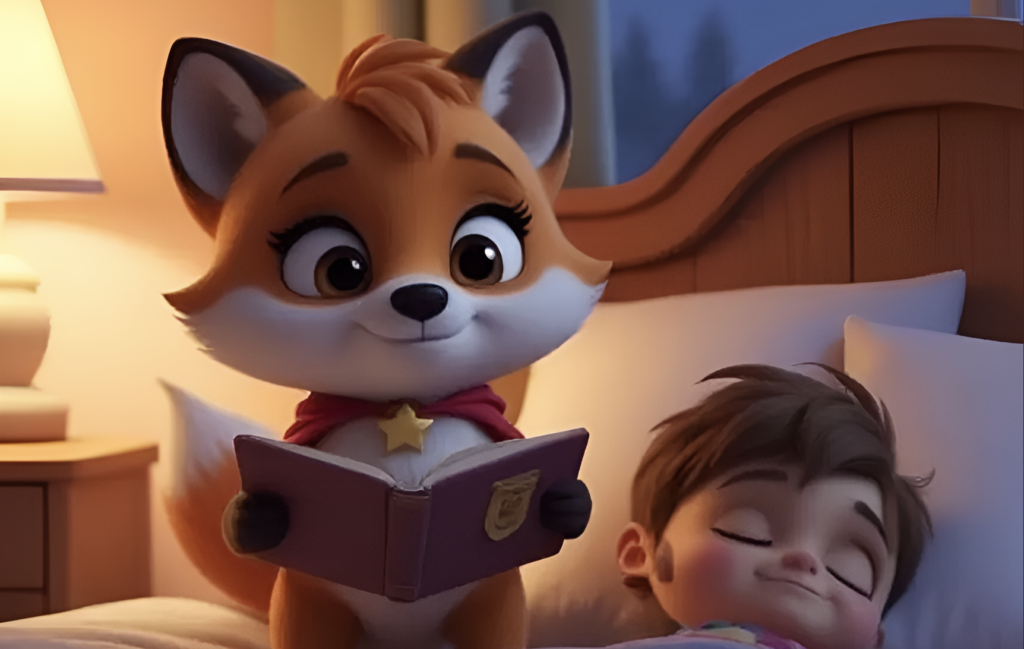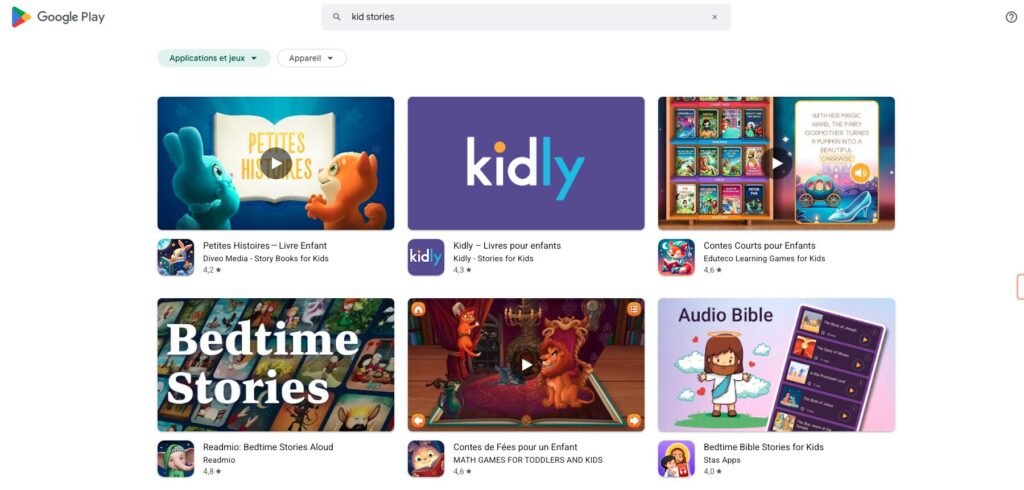Have you ever witnessed a child unlock the power of language, transforming simple words into meaningful sentences? I’ll never forget the moment my niece, Emma, went from saying “ball” to telling me, “Auntie, the red ball rolled under the couch!” It was like watching a tiny explorer discover a new world.
That’s the magic of storytelling—it transforms babble into meaningful sentences, one word at a time. Lunesia’s innovative approach to storytelling creates a foundation for language development in young children, making it an invaluable tool for parents and educators.
Research shows that children retain 68% more new words through contextual stories than through traditional methods. This highlights the effectiveness of Lunesia’s stories in supporting vocabulary development. By engaging narratives that capture children’s imagination, Lunesia introduces new words naturally, fostering a love for language and reading.
The Science Behind Storytelling and Vocabulary Development
The connection between storytelling and vocabulary development is more than just anecdotal – it’s backed by compelling scientific evidence. When children hear stories, their brains respond in unique ways that passive listening can’t match.
How Stories Activate Brain Development in Young Children
Research shows that storytelling activates seven times more brain regions than passive listening, helping kids process and retain information better. This activation creates stronger neural pathways, which are crucial for vocabulary retention. The emotional engagement triggered by stories also releases neurochemicals that enhance memory formation and recall of new vocabulary words.
Storytelling isn’t just about reading words; it’s about creating a rich context that helps children understand and remember new words. By engaging multiple brain regions simultaneously, stories provide a robust foundation for language development.
Research on Narrative-Based Learning vs. Traditional Methods
Studies have shown that narrative-based learning is more effective than traditional methods like flashcards for vocabulary acquisition. According to The T.E.A. Center, children retain 68% more new words from contextual stories compared to flashcards. This significant difference highlights the importance of context in learning new vocabulary.
| Learning Method | Retention Rate |
|---|---|
| Narrative-Based Learning | 68% higher retention |
| Flashcards | Baseline retention |
This research underscores the value of using stories to teach vocabulary, as they provide a natural and engaging way for children to learn and remember new words.
Why Lunesia Vocabulary Growth Matters for Early Learners
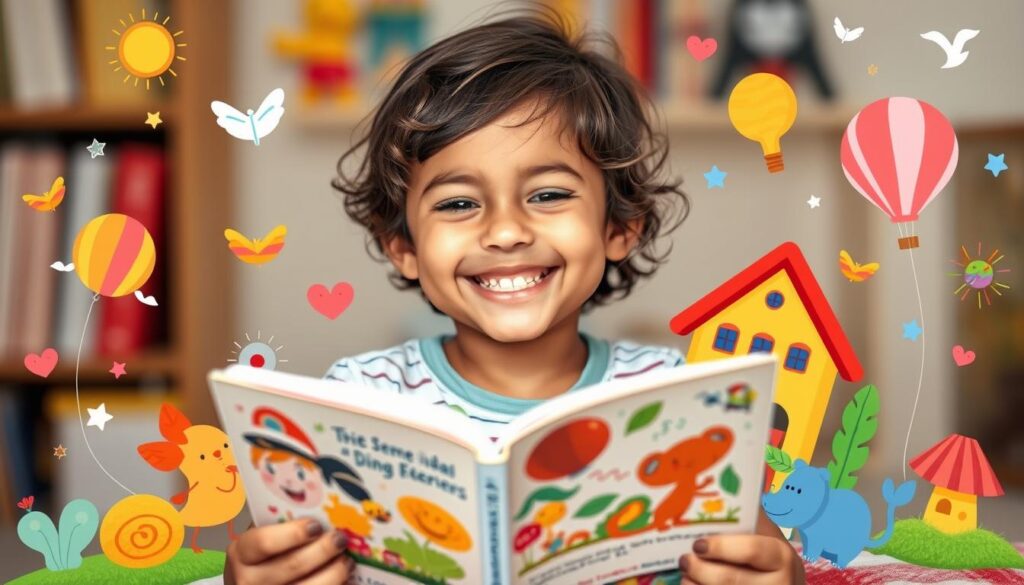
A strong vocabulary is the cornerstone of a child’s educational journey. As a parent or educator, you’re likely aware of the significance of early vocabulary development. Research shows that a child’s vocabulary growth is closely linked to their future academic success.
The Connection Between Early Vocabulary and Later Academic Success
Early vocabulary acquisition is a strong predictor of a child’s reading comprehension skills and overall academic performance. Studies have shown that children with larger vocabularies by age 3 tend to demonstrate stronger reading comprehension skills by third grade. This, in turn, sets them up for success in other academic areas, including writing and even math problem-solving.
The ripple effect of strong vocabulary skills is significant. When children have a robust vocabulary, they’re better equipped to understand complex concepts, express themselves effectively, and build confidence in their communication and social interactions.
How Lunesia’s Approach Aligns with Language Development Research
Lunesia’s approach to vocabulary development is grounded in language acquisition research, focusing on contextual learning rather than isolated word memorization. By using engaging narratives, Lunesia creates natural opportunities for children to encounter tier 2 vocabulary words – sophisticated words used across multiple contexts – that are crucial for academic language.
This research-based approach aligns with what we know about optimal language development timing and methods. By leveraging Lunesia’s stories, you can help your child build a strong foundation for future learning and academic success.
Stages of Language Development and How Lunesia Stories Support Each Phase
Language development is a fascinating journey that unfolds in distinct stages from infancy to early elementary years. Every child’s journey with words is unique, and storytelling plays a pivotal role in shaping their communication skills. At Lunesia, we understand the importance of tailoring stories to support each stage of language development.
Infancy to Toddlerhood (0-3 Years): Building Foundations
During the initial years, infants begin to recognize sounds and rhythms, laying the groundwork for language skills. Lunesia’s stories for this age group use melodic language, repetition, and simple vocabulary to stimulate neural pathways for language development. By exposing infants to these engaging narratives, we help build their foundational language skills.
Preschool Years (3-5 Years): Expanding Expression
As children enter the preschool years, their vocabulary expands rapidly. Lunesia’s stories for this stage introduce descriptive vocabulary and longer sentences, supporting their growing ability to express themselves. These narratives are designed to captivate young listeners and encourage them to articulate their thoughts and feelings more effectively.
Early Elementary (5-8 Years): Refining Communication
In the early elementary years, children refine their communication skills through more complex narratives. Lunesia stories for this age group incorporate sophisticated vocabulary, figurative language, and complex sentences, enhancing their ability to convey nuanced ideas. By engaging with these stories, children develop a more refined understanding of language and its applications.
By understanding the different stages of language development, parents can better support their child’s growth. Lunesia’s stories are designed to be both engaging and educational, ensuring that children are challenged with new words while maintaining an optimal balance of familiar vocabulary.
Key Features of Lunesia Stories That Enhance Vocabulary Acquisition
The intentional design of Lunesia stories makes them particularly effective for enhancing vocabulary in early learners. Research has shown that we learn words up to four times faster in a familiar context than in an unfamiliar one (Landauer & Dumais, 1997; Hirsch, 2006). Lunesia stories capitalize on this by using engaging narratives that provide a rich context for new vocabulary.
Contextual Learning Through Engaging Narratives
Lunesia stories use contextual learning by building new vocabulary upon themes and settings that children already understand. This approach helps children learn new words in a meaningful way, making it easier for them to remember and use them correctly. By leveraging familiar contexts, Lunesia stories make vocabulary acquisition a natural part of the storytelling experience.
Repetition and Pattern Recognition in Story Structure
Strategic repetition of key vocabulary words throughout Lunesia stories reinforces their meaning without feeling forced or didactic. Additionally, Lunesia’s unique pattern recognition elements help children anticipate and predict vocabulary, creating satisfying “aha” moments that strengthen word retention. This repetition and pattern recognition are crucial for solidifying new words in a child’s memory.
Visual Supports and Their Impact on Word Retention
The thoughtfully designed visual supports in Lunesia stories provide contextual clues for unfamiliar words, making their meaning accessible without direct explanation. By using visual aids, Lunesia stories help children connect new vocabulary to their existing knowledge, enhancing comprehension and retention.
| Feature | Description | Benefit |
|---|---|---|
| Contextual Learning | New vocabulary is introduced within familiar themes and settings. | Enhances understanding and retention of new words. |
| Repetition and Patterns | Key vocabulary is repeated throughout the story, and patterns are used to help predict new words. | Reinforces vocabulary and strengthens word retention. |
| Visual Supports | Images and illustrations provide contextual clues for new vocabulary. | Facilitates comprehension and retention of new words without needing direct explanation. |
Effective Techniques for Reading Lunesia Stories Aloud
To maximize the benefits of Lunesia stories for your child’s vocabulary growth, it’s essential to master the art of reading aloud. The way you read can significantly impact your child’s language development and comprehension. By incorporating effective techniques into your storytelling, you can create a rich and engaging experience that fosters a love for reading and learning.
Expressive Language and Voice Modulation
One of the most powerful tools you have as a reader is your voice. Using expressive language and voice modulation can help bring Lunesia stories to life. Try “voice mapping,” where you assign unique tones to different characters. This technique not only captivates your child’s attention but also helps them connect emotions to vocabulary words, creating stronger memory associations. For example, you can use a gentle tone for a kind character and a bold tone for a brave one.
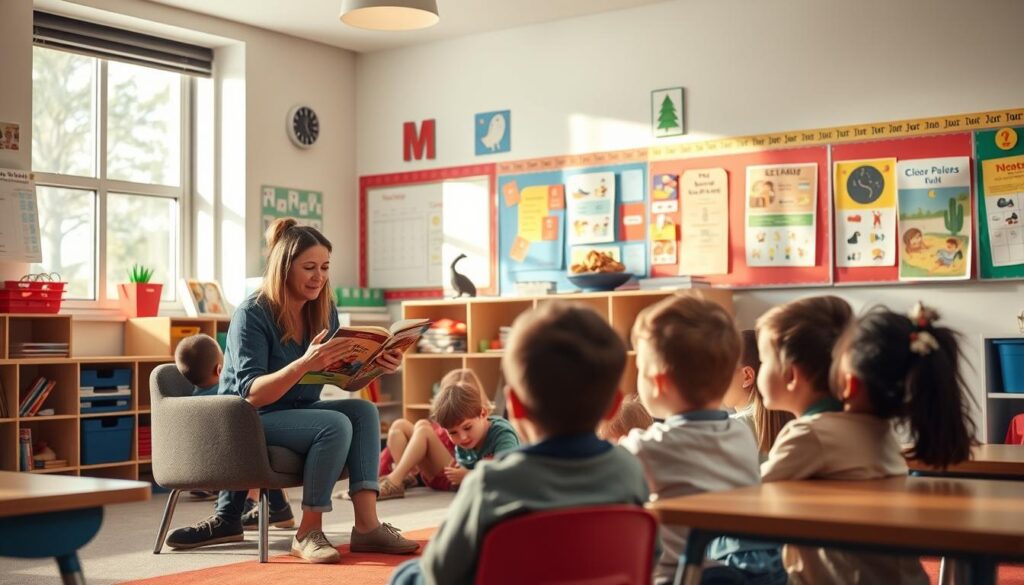
Strategic Pausing and Question Techniques
Strategic pausing during readings allows your child time to process new words and make predictions about their meanings. It’s also an opportunity to engage your child with questions that prompt them to think about the story without disrupting its flow. Ask open-ended questions like “What do you think will happen next?” or “How do you think the character is feeling?” This encourages active learning and comprehension.
Balancing Explanation and Context
It’s tempting to explain every unfamiliar word, but over-explaining can disrupt the story’s flow. Instead, let the context reveal the meaning naturally. For instance, if your child encounters an unknown word, you can say, “Let’s keep reading to see what happens next.” This approach helps your child learn to infer meaning from the context, a crucial skill for language development.
Interactive Storytelling Activities to Reinforce New Vocabulary
Interactive storytelling is a powerful tool for reinforcing new vocabulary in children. By making stories come alive, we can create a more engaging and effective learning experience. Daily storytelling with interactive elements can significantly enhance vocabulary acquisition.
One of the most effective ways to achieve this is through role-playing and character embodiment exercises. By acting out characters and scenes from Lunesia stories, children can internalize new vocabulary in a fun and engaging way.
Role-Playing and Character Embodiment Exercises
Role-playing activities based on Lunesia characters help children use new vocabulary in context. For example, creating a “story costume box” filled with hats, scarves, and stuffed animals can spark imagination and encourage children to embody characters. This embodied learning experience makes vocabulary more memorable.
Creating Story Extensions and “What Happens Next” Games
Another engaging activity is creating story extensions where children can practice using newly acquired vocabulary in their own creative narratives. “What Happens Next” games encourage children to predict story outcomes while incorporating target vocabulary from Lunesia stories. This not only reinforces vocabulary but also develops critical thinking skills.
Using Props and Visual Aids to Enhance Comprehension
Simple props and visual aids can significantly enhance comprehension of challenging vocabulary words. For instance, using everyday objects to represent story-related items can make abstract vocabulary concrete and memorable. This approach supports different learning styles and reinforces the vocabulary introduced in Lunesia stories.
| Activity Type | Benefits | Example |
|---|---|---|
| Role-Playing | Internalizes new vocabulary, encourages creativity | Acting out characters with props |
| Story Extensions | Develops creative writing, reinforces vocabulary | Creating alternative endings to stories |
| Visual Aids | Enhances comprehension, makes vocabulary concrete | Using objects to represent story elements |
By incorporating these interactive storytelling activities into daily routines, parents can create a rich vocabulary learning experience for their children. For more resources on enhancing vocabulary learning, visit Lunesia’s website.
Building a Language-Rich Environment with Lunesia Stories
Weaving words into daily life can transform your home into a vibrant tapestry of language and learning. By incorporating Lunesia stories into your daily routines, you can create a nurturing environment that fosters a love for reading and comprehension in your child.
Daily Storytelling Routines for Different Age Groups
Establishing consistent storytelling routines tailored to different age groups can create anticipation and receptiveness to new vocabulary learning. For infants and toddlers, simple, interactive stories with engaging visuals can lay the foundation for language development. As children grow, you can adapt the complexity and themes of the stories to keep them engaged and challenged.
Integrating Story Vocabulary into Everyday Conversations
Naturally integrating vocabulary from Lunesia stories into everyday conversations can reinforce new words in multiple contexts, enhancing retention and understanding. For example, if a story includes the word “exuberant,” you can use it to describe your child’s energetic behavior, making the word more relatable and memorable.
Creating Dedicated Reading Spaces at Home
Designating a special reading space at home can signal to children that it’s time to focus on stories and language, enhancing their receptivity to new vocabulary. Make this space cozy and inviting, filled with books, comfortable seating, and minimal distractions. For more insights on maximizing vocabulary learning, you can visit Lunesia’s review page for additional resources.
| Age Group | Storytelling Approach | Vocabulary Integration |
|---|---|---|
| Infants (0-1 year) | Simple, interactive stories | Using story words during play |
| Toddlers (1-3 years) | Engaging visuals and repetition | Labeling objects with story vocabulary |
| Preschoolers (3-5 years) | Complex stories with themes | Discussing story themes in conversations |
How Parents Can Maximize Vocabulary Learning Through Lunesia Stories
By adopting a few simple techniques, parents can turn reading Lunesia stories into a powerful tool for vocabulary development. As a parent, your voice is the first story your child ever hears, and your role in shaping their understanding of the world is unparalleled.
Showing Genuine Interest in Words
Modeling enthusiasm and curiosity about words has a profound impact on children’s attitudes toward vocabulary learning. When parents display excitement about new words, children are more likely to embrace them. For instance, you can say, “I love the word ‘exuberant’! It means full of energy and enthusiasm.” This simple act can spark a child’s interest in words and their meanings.
Fostering Discussions
Encouraging questions and extended discussions about the story can deepen a child’s understanding of new vocabulary. When your child asks about an unfamiliar word, respond in a way that encourages further exploration. For example, you could ask, “What do you think ‘serene’ means in this context?” This approach not only helps with vocabulary but also develops critical thinking skills.
Relating Stories to Life
Connecting Lunesia stories to your child’s real-life experiences helps cement vocabulary by creating meaningful personal associations with new words. For instance, if a story mentions a “sunny day,” you could relate it to a recent outing you enjoyed together on a sunny day, reinforcing the word’s meaning in a tangible way.
By implementing these strategies, parents can maximize their child’s vocabulary learning through Lunesia stories, creating a rich and engaging learning environment that extends beyond the story itself.
Selecting the Right Lunesia Stories for Different Learning Goals
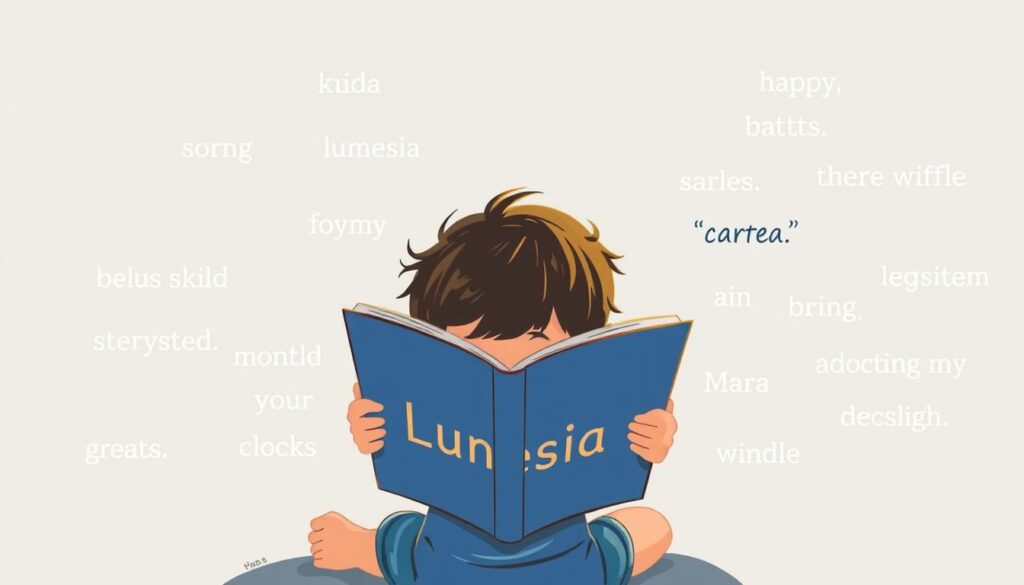
Finding the perfect Lunesia stories for your child involves understanding their current vocabulary level and learning goals. With a vast collection of stories, Lunesia offers a tailored approach to vocabulary development.
Stories That Introduce Specific Word Categories
Lunesia stories are designed to introduce specific word categories, such as emotions, actions, or descriptive language, allowing for targeted vocabulary development. For example, stories that focus on emotional intelligence help children understand and express their feelings more effectively.
Progressive Difficulty Levels for Vocabulary Growth
Lunesia’s progressive difficulty system ensures that vocabulary growth is scaffolded, introducing more complex words as children master earlier levels. This approach keeps the learning process engaging and challenging yet manageable.
Culturally Diverse Stories for Broader Language Exposure
The inclusion of culturally diverse stories in Lunesia’s collection provides children with exposure to vocabulary from different contexts and traditions. This broadens their language horizons and enhances their understanding of the world.
By strategically selecting Lunesia stories based on your child’s learning goals and current vocabulary level, you can create a personalized learning experience. This approach not only enhances their vocabulary growth but also fosters a love for reading and learning.
Combining Digital and Traditional Storytelling with Lunesia
Lunesia’s innovative approach combines the best of digital and traditional storytelling to create a comprehensive vocabulary learning experience for today’s children. By thoughtfully integrating digital tools with traditional methods, Lunesia provides a robust foundation for vocabulary acquisition.
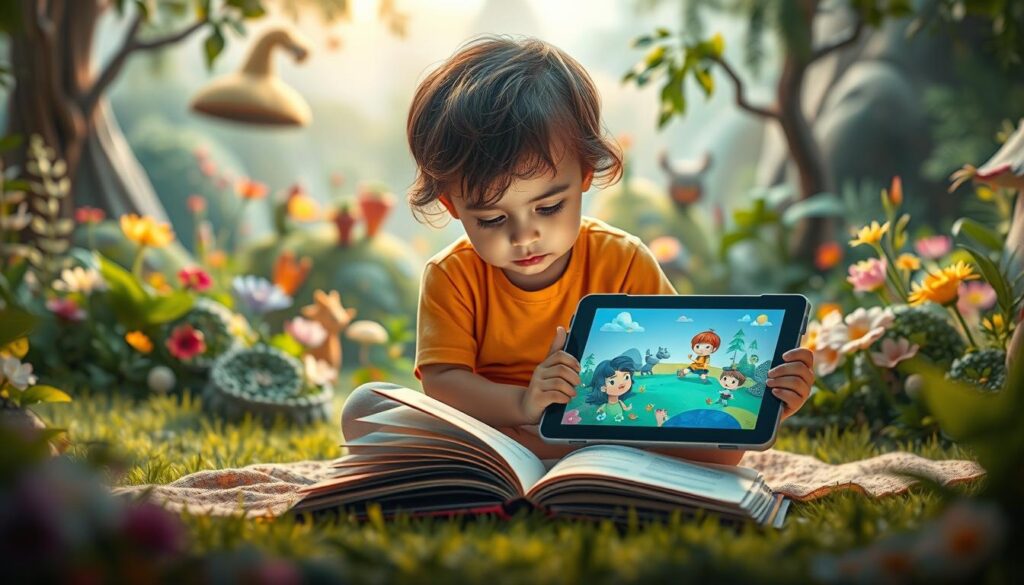
Digital Story Resources and Features
Lunesia’s digital story resources are designed to enhance vocabulary acquisition through multimedia engagement and personalized learning paths. The digital stories use highlighting, pronunciation guides, and interactive elements to reinforce vocabulary in ways that complement traditional book reading. These features make learning more engaging and accessible for young children.
The digital platform offers a range of interactive features that cater to different learning styles. For instance, the highlighting feature helps children focus on specific words, while pronunciation guides ensure they learn the correct pronunciation. Interactive elements, such as quizzes and games, further reinforce vocabulary acquisition.
| Feature | Description | Benefit |
|---|---|---|
| Highlighting | Highlights specific vocabulary words | Focuses attention on key words |
| Pronunciation Guides | Provides audio pronunciation of words | Improves pronunciation skills |
| Interactive Elements | Includes quizzes and games related to the story | Reinforces vocabulary acquisition through engagement |
Balancing Screen Time with Physical Books
While digital storytelling offers many benefits, it’s essential to balance screen time with traditional book reading. Lunesia’s approach allows parents to create a healthy mix of both, maximizing vocabulary benefits while minimizing potential downsides. By integrating digital and traditional methods, Lunesia provides a well-rounded learning experience.
To achieve this balance, parents can alternate between digital and physical stories, ensuring that children are exposed to a variety of formats. This not only keeps learning fresh and engaging but also helps in developing different skills associated with each format.
Using Technology to Track Vocabulary Progress
Lunesia’s technology allows parents and educators to track vocabulary progress over time, identifying patterns in learning and areas that need additional support. This feature is invaluable in tailoring the learning experience to each child’s needs, ensuring that they receive the right level of challenge and support.
By monitoring progress, parents can adjust their approach as needed, celebrating successes and addressing any challenges that arise. This ongoing assessment and adjustment process is crucial for optimizing vocabulary acquisition.
Tracking and Celebrating Vocabulary Growth Through Lunesia Stories
As children explore Lunesia stories, tracking their vocabulary growth becomes an exciting journey. It’s essential to make this process both fun and rewarding to keep children motivated about learning new words.
Creating Word Journals and Vocabulary Maps
One effective way to track vocabulary growth is by creating word journals or vocabulary maps connected to Lunesia stories. This method helps children visualize their growing word bank and take ownership of their learning. You can use simple notebooks or digital tools to create these journals, making it a fun activity by including pictures or sentences using the new words.
- Encourage your child to draw a picture representing the new word.
- Write a sentence using the new word in context.
- Use sticky notes or digital bookmarks to mark new words in Lunesia stories.
Recognizing and Reinforcing New Word Usage
Recognizing and reinforcing your child’s spontaneous usage of new words from Lunesia stories in everyday conversation is crucial. This practice strengthens their confidence and retention of the vocabulary. Celebrate their efforts by acknowledging when they use new words correctly, making it a positive reinforcement.
For example, you can create a “Word Wizard” award for using a certain number of new words in a day or week. This gamification of vocabulary learning makes it engaging and fun, promoting continued progress.
Conclusion
As we conclude our exploration of Lunesia’s impact on early learners, it’s clear that vocabulary growth is a journey, not a destination. Lunesia’s stories have shown us that language learning can be a joyful, natural experience for young children.
The consistent use of Lunesia stories creates cumulative benefits for vocabulary growth that extend far beyond individual reading sessions. By trusting this process, parents can give their child the tools to express themselves and understand their world.
The vocabulary skills developed through Lunesia’s approach will serve as a foundation for all future learning and communication. I encourage you to begin or continue using Lunesia stories as a cornerstone of your child’s language development journey.
Join our community of parents supporting their children’s vocabulary growth through the power of Lunesia’s thoughtfully crafted stories. Together, let’s nurture a love for words and language that will last a lifetime.
FAQ
How can I help my child learn new words through storytelling?
You can help your child by reading stories aloud with enthusiasm and encouraging them to ask questions about unfamiliar words. This interactive approach helps build their vocabulary and comprehension skills.
What are some effective ways to teach vocabulary to early learners?
Using context clues within stories is an effective method. You can also use visual aids like pictures or props to support word learning and retention.
How often should I read stories to my child to support their language development?
Reading stories regularly, ideally daily, can significantly support your child’s language development. Establishing a consistent storytelling routine can be particularly beneficial.
Can Lunesia stories be used for children of different ages and learning abilities?
Yes, Lunesia stories are designed to cater to various age groups and learning needs. You can select stories that match your child’s developmental stage and learning goals.
How can I track my child’s vocabulary progress over time?
You can create a word journal or vocabulary map to track new words your child learns. This activity helps reinforce their understanding and usage of new vocabulary.
Are there any digital tools or features that can support vocabulary learning with Lunesia stories?
Yes, Lunesia offers digital story resources and features that can enhance vocabulary learning. These tools can help you track progress and provide a more engaging learning experience.
How can I make storytelling a more engaging experience for my child?
Using expressive language, voice modulation, and strategic pausing can make storytelling more engaging. You can also incorporate role-playing and character embodiment exercises to enhance the experience.

